G3BNG Controller Interfacing¶
The G3BNG controller contains a rich set of I/O interfaces which are discussed in detail in the following sections. The table below lists the on board connectors and pins, ports and busses available on those connectors.
Connector |
Port(s) |
|---|---|
See location annotatations in the image below showing I/O connectors listed in the previous table.
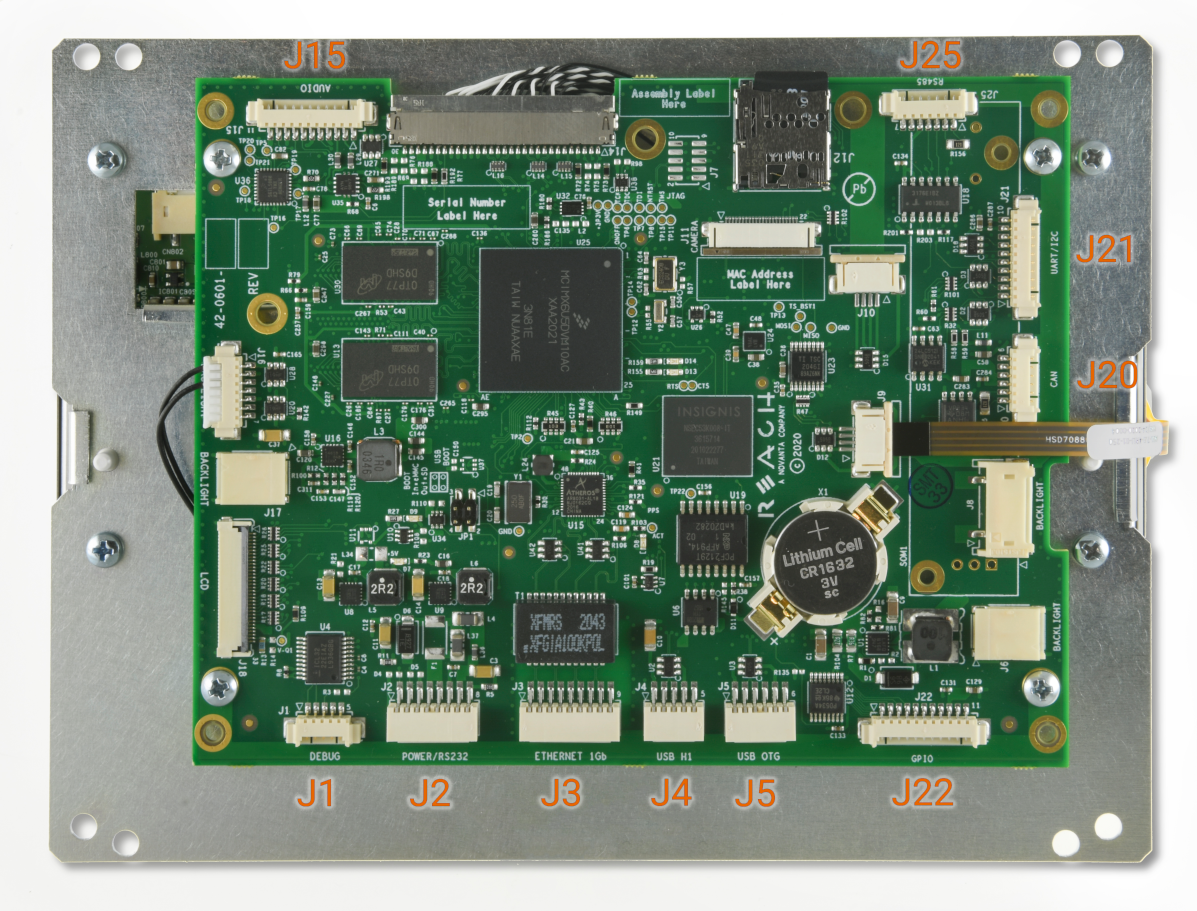
G3BNG I/O Connector Locations¶
Power¶
Connect DC power for the G3BNG controller and the touch panel via J21. Although the exact power consumption depends on peripherals as well as the particular touch panel, generally, the package will consume approximately 7W to 15W when the backlight is active.
G3 modules with 7” and smaller displays must be driven with a 5V, 3A DC power source. G3BNG controllers coupled with larger displays (e.g. 10.1” and greater) must be driven with a 12V, 1.5A DC power source.
Footnotes:
- 1
Use Reach Technology “Y” cable, PN 23-0160-18 for 5 VDC or PN 23-0173-18 for 12 VDC, if you do not wish to build custom cables.
Console (Debug) Port¶
Access the controller debug interface via J12. This RS-232 level serial port runs at 115.2k Baud, 8-bit, no parity, 1 stop bit. This port should always be connected during product development. You will need a terminal emulator program or shell that understands ANSI color escape sequences. Examples include Tera Term or PuTTY3 (Windows) or picocom in a bash shell (Linux).
Footnotes:
RS-232 Port¶
A standard RS-232 port4 is also available on J25.
Footnotes:
GigaBit Ethernet¶
A standard 1000baseT6 network port is available on J37.
Footnotes:
USB 2.0 Host Port¶
Connect standard USB 1.0 and USB 2.0 peripherals8 to J49.
Footnotes:
USB 2.0 OTG Port¶
If J4 is already in use10 or you want to use the G3BNG as a USB device11 rather than as a host, you can use the USB 2.0 OTG port on J5. This port is capable of being either a host port12 or a device port13.
Footnotes:
- 10
For example by an HID touch controller.
- 11
For example as a Linux Network Gadget for peer to peer USB networking.
- 12
Use Reach Technology USB Host cable, PN 23-0167-12, if you do not wish to build custom cables.
- 13
Use Reach Technology USB Device cable, PN 23-0168-12, if you do not wish to build custom cables.
Audio¶
Stereo headphones, a mono microphone and/or a mono speaker can be connected to J1514.
Footnotes:
- 14
Use Reach Technology audio flying leads cable, PN 23-0144-10, for prototyping.
CAN Bus¶
A CAN bus connection is available on J2015.
Footnotes:
- 15
Use Reach Technology CAN flying leads cable, PN 23-0146-10, for prototyping.
UART¶
A logic level16 serial port is available on J2117.
Footnotes:
I2C Bus¶
The I2C Bus is also available on J2118.
Footnotes:
- 18
Use Reach Technology I2C/UART/GPIO flying leads cable, PN 23-0149-10, for prototyping.
GPIO¶
GPIO pins are available on J2119 and J2220.
Footnotes:
RS-485 Port¶
Full duplex RS-48521 peripherals can be connected to J2522.
Footnotes:
PCIe¶
Note
The PCIe connector is not currently supported.
Connector Pinouts and Part Numbers¶
The following sections provide the pinout for each connector and part number for the required mating plug.
J1¶
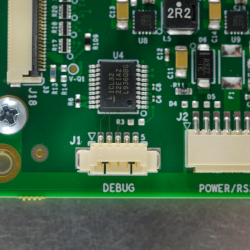
G3BNG Debug Interface Connection¶
5 pin PicoBlade, MOLEX Part # 51021-0500
Pin |
Signal |
|---|---|
1 |
TxD output ESD protected23 |
2 |
RxD input ESD protected23 |
3 |
Boot_Mode_124 |
4 |
GND |
5 |
GND |

G3BNG Debug Interface Schematic¶
Footnotes:
J2¶
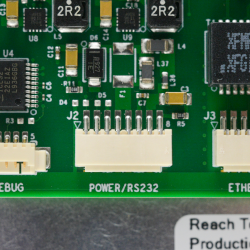
G3BNG Power, RS-232 Connection¶
8 pin Pico-SPOX, MOLEX Part # 87439-0800
Pin |
Signal |
|---|---|
1 |
TxD output ESD protected25 |
2 |
RxD input ESD protected25 |
3 |
GND (power and communications) |
4 |
VIN 5V up to 12V DC input26 |
5 |
VIN 5V up to 12V DC input26 |
6 |
GND (power and communications) |
7 |
V INV optional backlight voltage source27 |
8 |
GND (power and communications) |
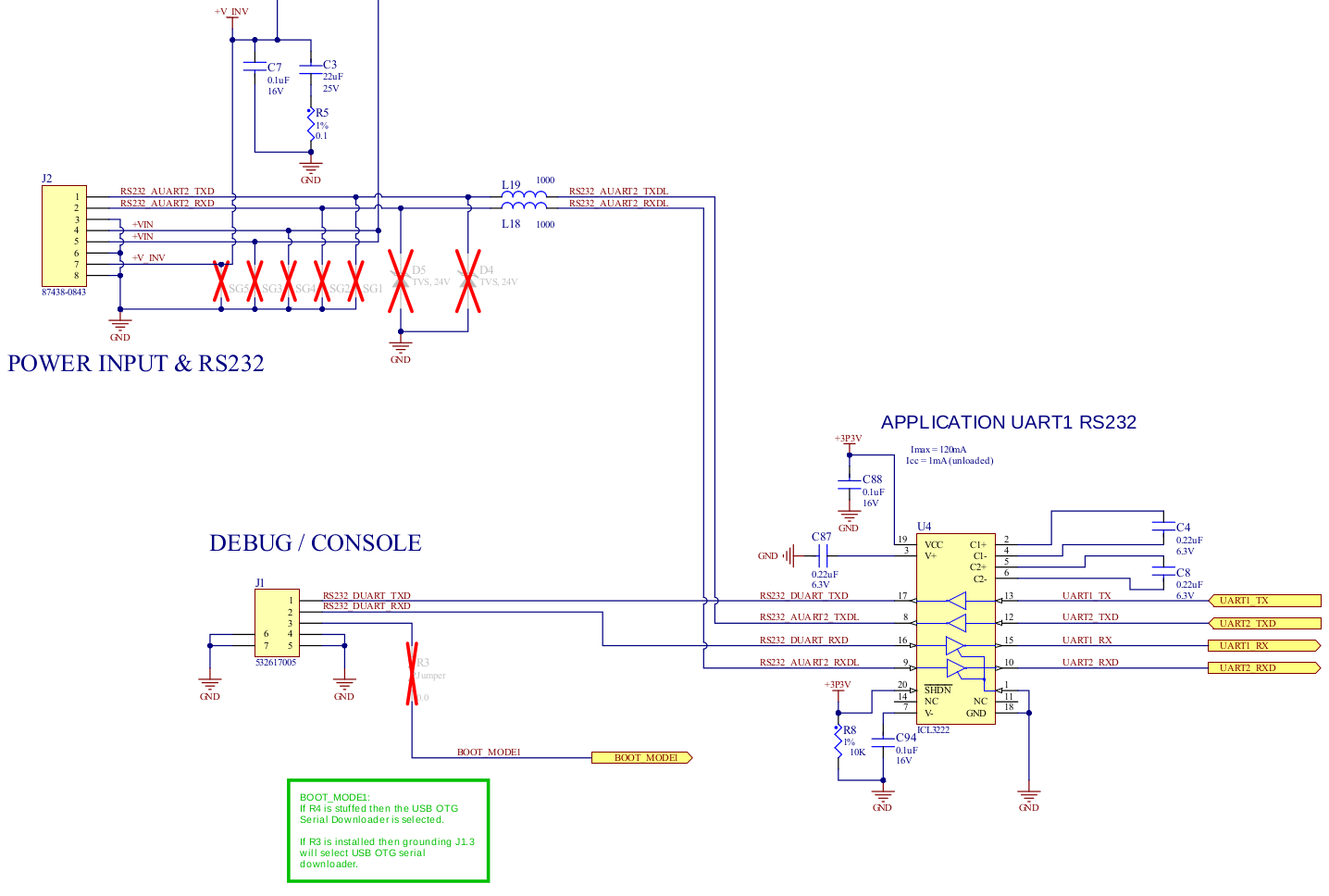
G3BNG Power, RS-232 Schematic¶
Footnotes:
J3¶
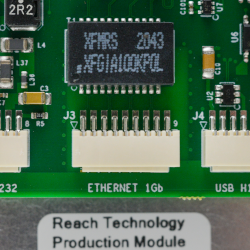
G3BNG GigaBit Ethernet Connection¶
9 pin Pico-SPOX, MOLEX Part # 87439-0900
Pin |
Signal |
|---|---|
1 |
Bi-Directional pair D1+ |
2 |
Bi-Directional pair D1- |
3 |
Bi-Directional pair D2+ |
4 |
Bi-Directional pair D2- |
5 |
Bi-Directional pair D3+ |
6 |
Bi-Directional pair D3- |
7 |
Bi-Directional pair D4+ |
8 |
Bi-Directional pair D4- |
9 |
Ethernet Shield/GND |
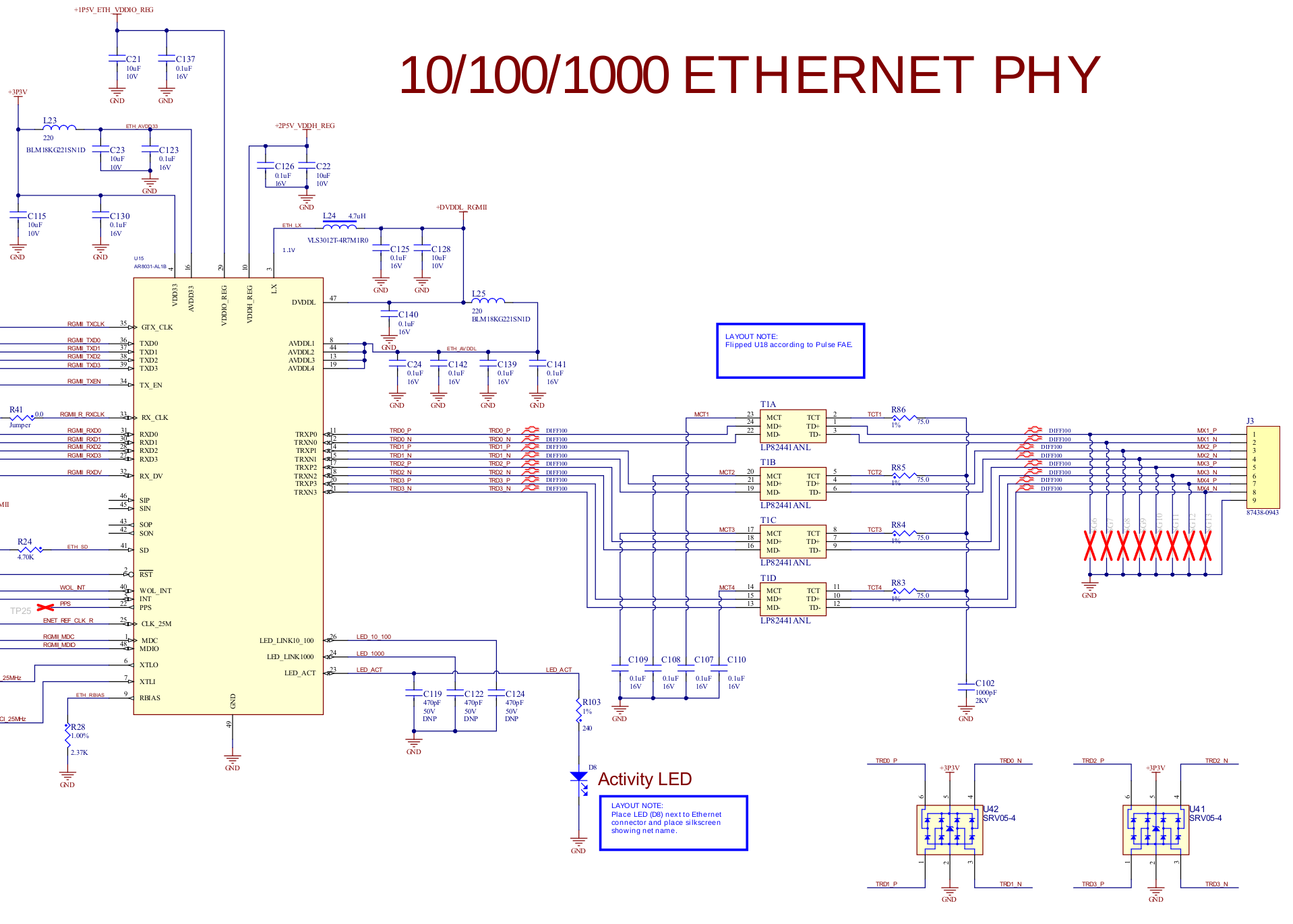
G3BNG GigaBit Ethernet Schematic¶
J4¶
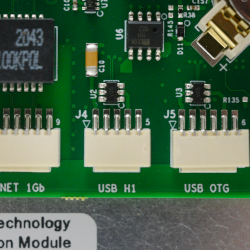
G3BNG USB 2.0 Host Port Connection¶
5 pin Pico-SPOX, MOLEX Part # 87439-0500
Pin |
Signal |
|---|---|
1 |
+5V |
2 |
Data - |
3 |
Data + |
4 |
GND |
5 |
GND shield |
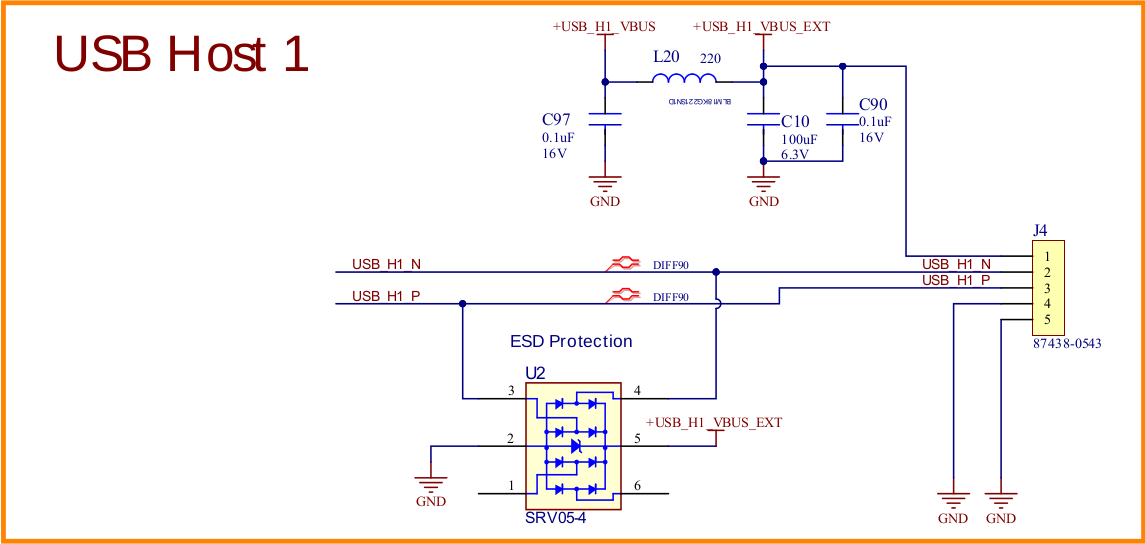
G3BNG USB 2.0 Host Port Schematic¶
J5¶

G3BNG USB 2.0 OTG Port Connection¶
6 pin Pico-SPOX, MOLEX Part # 87439-0600
Pin |
Signal |
|---|---|
1 |
+5V |
2 |
Data - |
3 |
Data + |
4 |
USB_OTG_ID28 |
5 |
GND |
6 |
GND shield |
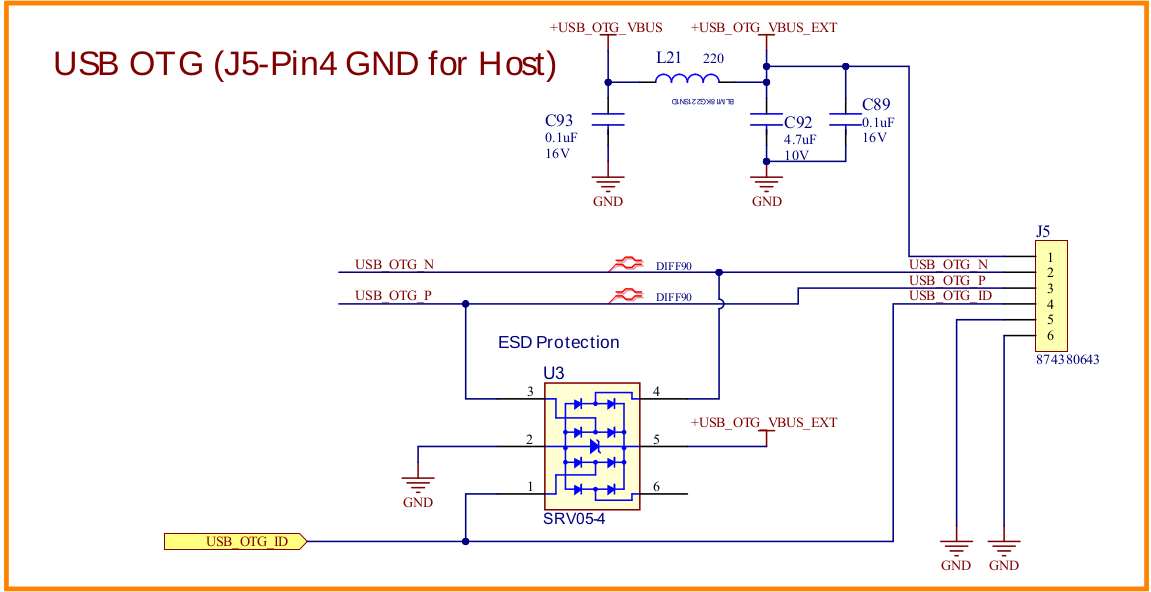
G3BNG USB 2.0 OTG Port Schematic¶
Footnotes:
- 28
Ground to make J5 a USB Host port.
J15¶
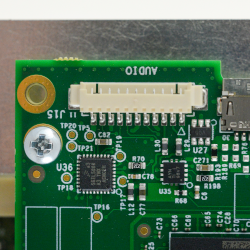
G3BNG Audio Connection¶
11 pin PicoBlade, MOLEX Part # 51021-1100
Pin |
Signal |
|---|---|
1 |
Analog GND |
2 |
Speaker connection +29 |
3 |
Speaker connection – |
4 |
Analog GND |
5 |
External headphone detect |
6 |
Analog GND |
7 |
Headphone output left |
8 |
Headphone output right |
9 |
Analog GND |
10 |
Microphone input left30 |
11 |
Headphone virtual GND |

G3BNG Audio Schematic¶
Footnotes:
J20¶
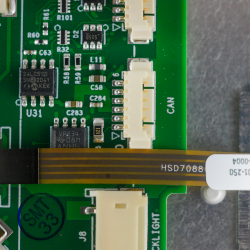
G3BNG CAN Bus Connection¶
6 pin PicoBlade, MOLEX Part # 51021-0600
Pin |
Signal |
|---|---|
1 |
CAN + |
2 |
CAN - |
3 |
+5V |
4 |
+5V |
5 |
GND |
6 |
GND |

G3BNG CAN Bus Schematic¶
J21¶
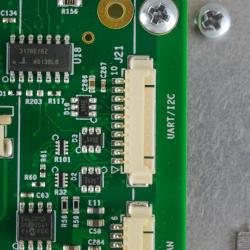
G3BNG UART / I2C Bus / GPIO Connection¶
10 pin PicoBlade, MOLEX Part # 51021-1000
Pin |
Signal |
|---|---|
1 |
UART5_RX |
2 |
UART5_TX |
3 |
GPIO6_IO15R |
4 |
GPIO2_IO10R |
5 |
UART5_CTS_B |
6 |
I2C3_SCL_BUF |
7 |
I2C3_SDA_BUF |
8 |
GND |
9 |
+3.3V |
10 |
GND |
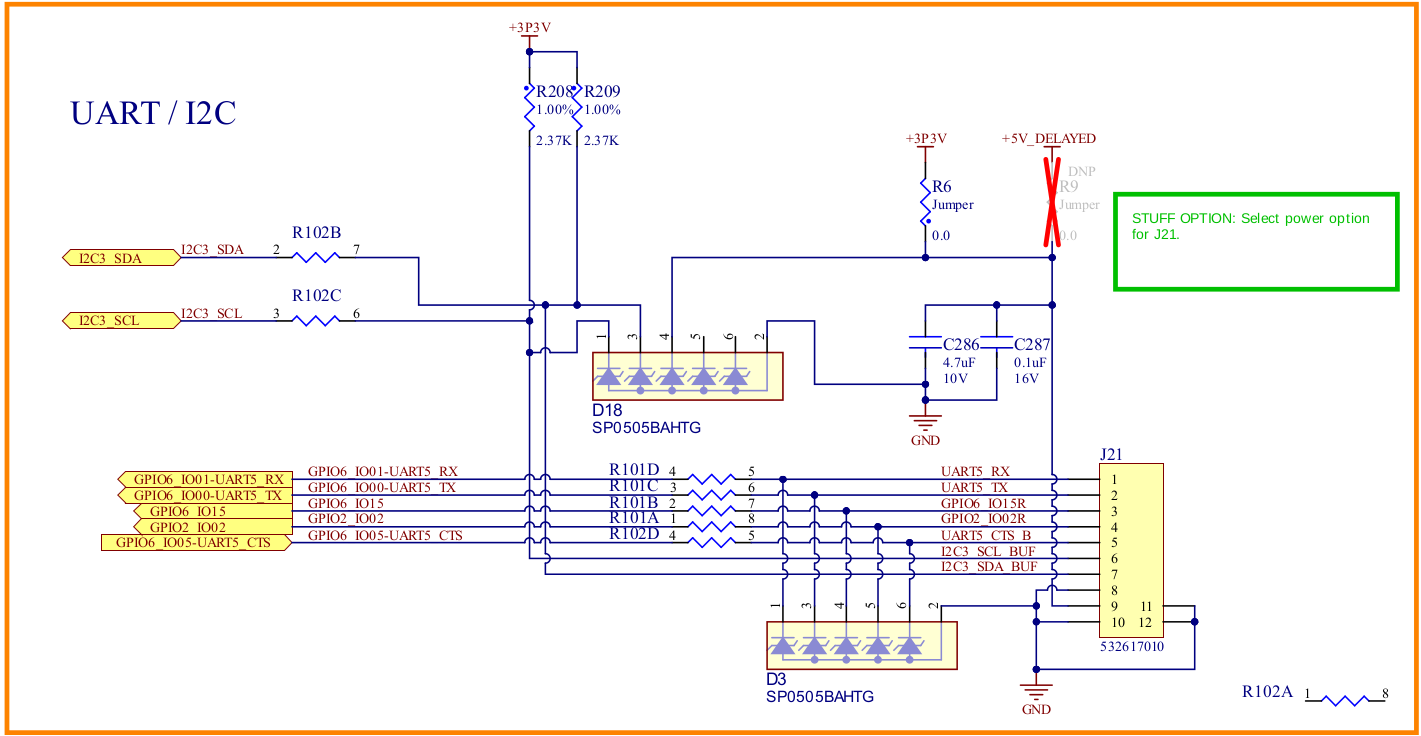
G3BNG UART / I2C Bus / GPIO Schematic¶
J22¶
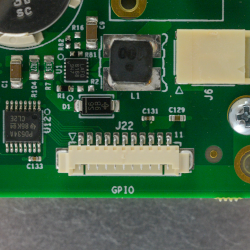
G3BNG GPIO Connection¶
11 pin PicoBlade, MOLEX Part # 51021-1100
Pin |
Signal |
|---|---|
1 |
GP3 |
2 |
GP2 |
3 |
GP1 |
4 |
GP0 |
5 |
GP4 |
6 |
GP5 |
7 |
GP6 |
8 |
GP7 |
9 |
+5V |
10 |
GND |
11 |
GND |
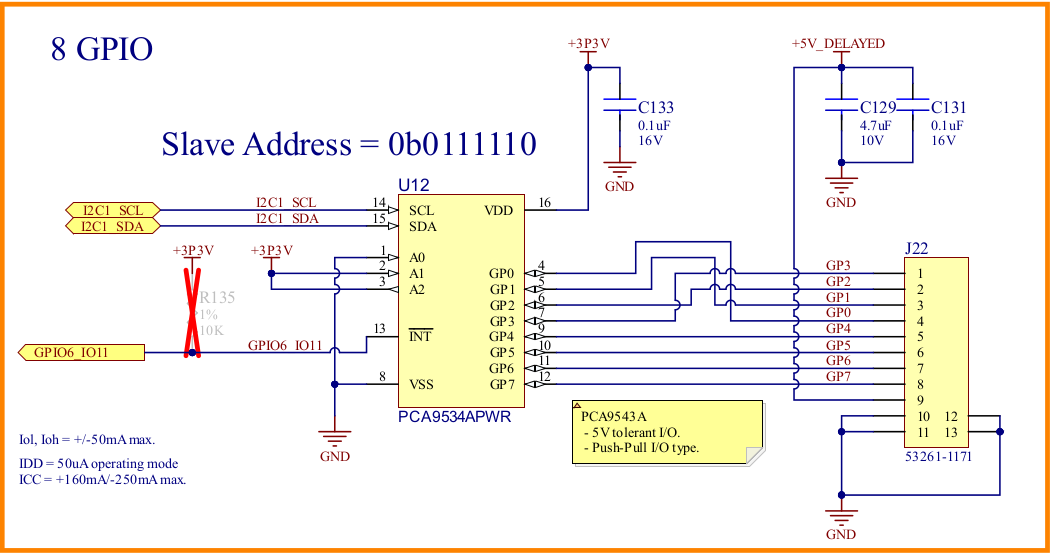
G3BNG GPIO Schematic¶
J25¶
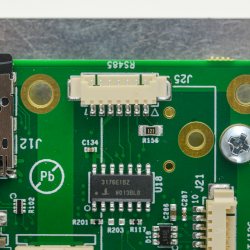
G3BNG RS-485 Port Connection¶
7 pin PicoBlade, MOLEX Part # 51021-0700
Pin |
Signal |
|---|---|
1 |
Rx H |
2 |
Rx L |
3 |
Tx L |
4 |
Tx H |
5 |
+5V |
6 |
GND |
7 |
GND |

G3BNG RS-485 Port Schematic¶